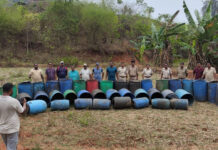A new Intergovernmental Panel on Climate Change (IPCC) report shows the impacts in the near future that can be avoided by limiting warming to 1.5 degrees Celsius instead of 2 degrees C
A mere half a degree could spell the difference between the Arctic being ice-free once a decade and once a century; between coral reefs being almost entirely wiped out and up to 30 percent hanging on; and between a third of the world’s population being exposed to extreme heat waves and a tenth.
These alternate futures were laid out recently in a new report from the Intergovernmental Panel on Climate Change (IPCC) that explores the possibility of limiting global temperature rise to 1.5 degrees Celsius above preindustrial times by 2100, instead of the 2-degree C upper limit agreed to in the landmark Paris agreement three years ago. The report exposes the closing window humanity has to choose which future it wants.
Preventing a temperature rise of 2 degrees C will be a major challenge, one that the current commitments from various countries will likely be unable to meet. And that is before President Donald Trump pulls the U.S. out of the agreement. But the report says a 1.5-degree C limit is not impossible—although it will require immediate and drastic action, because the current pace of emissions would breach that level between 2030 and 2052. The most likely scenario for achieving that goal may require blowing past it, and then sucking carbon dioxide out of the atmosphere to bring temperatures back in line.
With disruptions to the climate system already being felt now amid just less than 1 degree C of warming, even the 1.5-degree C goal seems poised to bring major negative impacts. Preventing another half degree of warming on top of that, however, would spare entire ecosystems, cities and vulnerable populations from exponentially worse damage. “We still have choices to make; we’ve seen some of the leading-edge damage already,” says Kim Cobb, a climate scientist at Georgia Institute of Technology, who is an author on the next major IPCC report.
Here are some of the climate consequences that can be avoided if warming is limited to 1.5 degrees C:
The Climate Crisis Heats Up:
Heat:
Rising average temperatures have a clear connection to how often heat waves happen, and how bad they get when they do. Studies have already shown the fingerprints of global warming on major heat waves in today’s climate, and things will only get worse as temperatures on the hottest days rise faster than the global average. One study cited in the new report used climate models to see how the share of the world’s population exposed to a heat wave (one with a 5 percent chance of occurring in any given year) would change. That number increased from less than 10 percent of the population now to 50 percent with 1.5 degree C of warming, and more than 70 percent at 2 degrees C.
Ecosystems:
Coral reefs have already been battered by warming and acidifying oceans, with widespread bleaching in recent years. Reefs have one of the bleaker future outcomes: a temperature rise of 2 degrees C would eliminate 99 percent of today’s reefs whereas 1.5 degrees C could save a sliver of them, with losses between 70 and 90 percent. Other animals face major losses in places to live. The amount of climatically suitable habitat lost by vertebrates and plants would double from a 1.5- to 2-degree C regime, and triple for invertebrates.
Arctic:
The Arctic has already warmed at about double the rate of the planet as a whole, causing permafrost to thaw and sea ice to steadily melt. The jump from 1.5 to 2 degrees C could mean an extra 1.5 million to 2.5 million square kilometers of permafrost disappear, while the Arctic Ocean would go from seeing ice-free conditions in the summer once every 100 years to once every 10.
Food and Water:
Warming temperatures also threaten the water and food sources humans depend on. Allowing the global temperature to rise by 2 degrees C could double the losses in annual ocean fish catches, up the number of people exposed to water stress by 50 percent and increase the declines in the yields of key staple crops such as maize, rice and wheat.












































